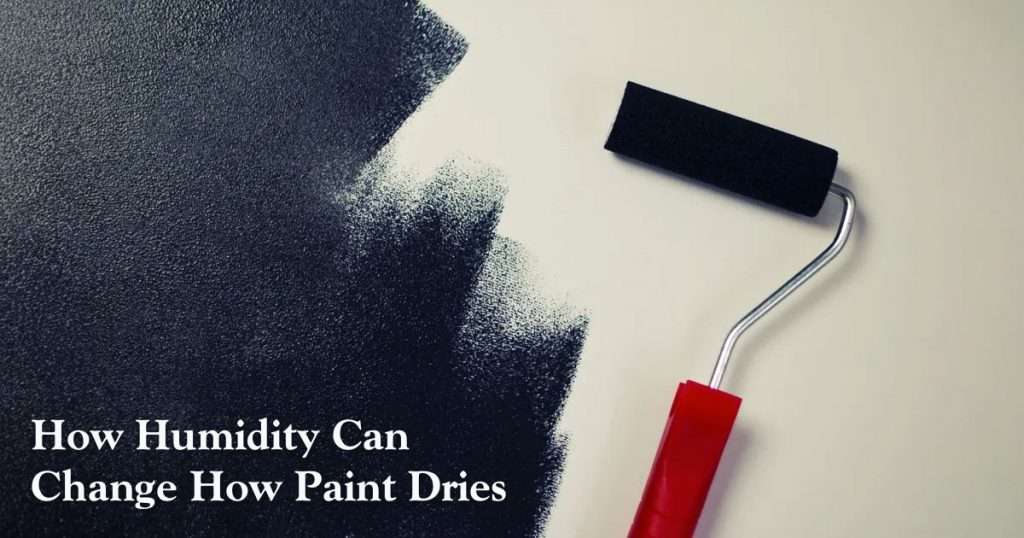Painting can be a rewarding way to freshen up your living space or add a splash of color to a room. However, when it comes to painting indoors, humidity is a factor that can impact the outcome of your project.
Can you paint in humid weather?
You can paint in humid weather, but it’s not ideal. High humidity can make it take longer for paint to dry and stick better, which can lead to a finish that isn’t perfect. If you have to paint in humid weather, make sure you use a fan, make sure there is enough airflow, and pick a paint that is made for high-humidity areas.
Ideal Humidity for Indoor Painting
The best humidity levels for painting outside are between 40% and 50%. Some moisture in the air actually helps paint dry better, preventing brush marks from drying too quickly and allowing them to flatten out.
When the humidity level gets to 70%, the paint will still dry, but it will do so more slowly. This could make the job harder and take longer for it to dry and cure.
Paint should not be applied when the humidity is above 85% or below 40%. At these extreme levels, the paint will not dry properly and may remain wet and gummy. Painting in these conditions can result in a wavy or streaky texture that is difficult to fix.
Does humidity affect painting indoors?
Humidity is all about how much moisture is in the air. When humidity levels are high, it can affect your painting project in several ways:
- Drying Time: In high humidity, paint can take longer to dry. This means you have to wait longer before applying additional coats or moving furniture back into the room.
- Adhesion: Paint may not stick to surfaces when there is a lot of wetness. This can lead to issues like peeling or bubbling, which can ruin the look of your paint job.
- Mold and Mildew: Mold and mildew can grow quickly in places with too much humidity. This can hurt your paint and put you and your family at risk for health problems.
- Color and Sheen: The color and shine of your paint can change because of the humidity. In high humidity, paint may look darker when wet and lighter when dry, which can be noticeable, especially with lighter colors.
Tips for Painting in High Humidity
If you find yourself needing to paint in high humidity, there are a few things you can do to help your paint job turn out well:
- Choose the Right Paint: When painting in a humid place, use paint made for high humidity. These paints dry faster in humid conditions, preventing problems like slow drying and poor sticking.
- Use a Dehumidifier: To get rid of moisture in the air, use a dehumidifier. This helps the paint dry faster and stick better. Running a dehumidifier in the painting room can speed up the drying process.
- Ensure Proper Ventilation: When it’s humid, good airflow is essential. To help the paint dry faster and lower the humidity, open windows and use fans to move air around.
- Avoid Extreme Conditions: If possible, don’t paint when the humidity is exceptionally high. This can cause issues like longer drying times and poor adhesion. Check the weather report and pick a day to paint when the temperature is not too high or too low.
- Use a Humidity Gauge: Monitor the humidity levels in the room using a humidity gauge. This can help you determine if conditions are suitable for painting.
- Thin Your Paint: If you’re using latex paint, consider thinning it slightly with water. Thinning the paint can help it dry faster in high humidity.
- Use a Heat Source: Using a heat source, such as a space heater or heat gun, can help speed up the drying process in high humidity.
- Use a Primer: Using a primer before painting can help improve adhesion and reduce the effects of high humidity on the final finish.
- Consider Using an Additive: Some paint additives are designed to help paint dry faster in humid conditions. Consider using one of these additives to improve drying times.
- Allow for Sufficient Drying Time: Wait a while between coats and let the paint dry completely. This may take longer in high humidity, but rushing the process can lead to issues with the finish.
Will the paint dry in high humidity?
Paint will eventually dry in high humidity, but it may take longer than usual. The type of paint, the temperature, and the humidity can all change how long it takes to dry. You should be patient and give the paint enough time to dry completely before adding more coats or touching up spots. Using techniques like proper ventilation, using a dehumidifier, and choosing the right paint can help speed up the drying process in high humidity.
Humidity Affects Interior Painting
Humidity can impact indoor surfaces, but indoor spaces can be controlled, unlike outdoor areas. Because rooms inside can be heated, cooled, and managed, humidity has less of an effect on painting inside.
Typically, humidity has little impact on interior walls. HVAC systems, baseboard heaters, window air conditioners, or other heating and cooling devices help maintain humidity levels.
Interior surfaces are generally protected and should not be exposed to moisture overnight. However, bathroom walls can accumulate moisture after showering.

